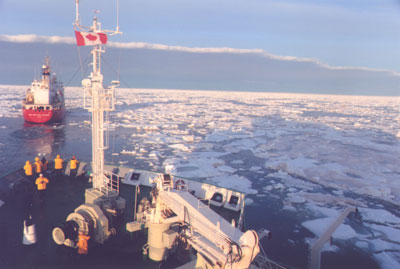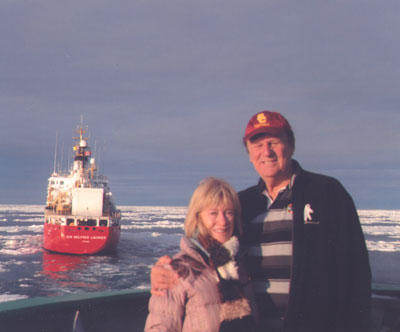Northwest Passage transit
The Northwest Passage is the sea route linking the North Atlantic and North Pacific oceans across the top of Canada. For eight years I’d looked for a way to follow in the footsteps of Arctic explorers like Roald Amundsen and Sir John Franklin, transiting the passage. In August ’09, on a 21-day expedition from ElderTreks (Toronto, Ont., Canada; 800/741-7956), my wife, Sandy, and I were among the lucky few to be able to have this experience.
From Ottawa, Canada, we flew via chartered plane to Resolute Bay in the high Arctic, where we boarded the icebreaker Akademik Ioffe by Zodiac inflatable. The ship has space for 107 passengers and a crew of 53. Sandy and I had chosen a top-of-the-line, bridge-level cabin, No. 608, so, for the two of us, the cruise cost $32,000*.
We unpacked in a hurry, as a lecture was about to begin. Quark Expeditions had arranged for lecturers, some of whom were excellent.
As we learned, when Arctic sea ice freezes in the winter, it first becomes a thick gray soup, then it turns into “pancakes.” The layers of young ice pile atop one another and compress against the ice from former years, forming hummocks and ridges. The new Arctic ice starts breaking up in July each year, creating a false sense of a navigable channel. The multiyear ice is more formidable than the newer ice.
Each day on our cruise, the crew received satellite photos of ice floes on our route, but, with changes in the wind and weather conditions, these were outdated almost immediately.
Our ship headed west through Lancaster Sound toward Beechy Island, where we had a chance to see polar bears and sea life and to take a hike. We paid tribute to explorers who have been laid to rest there.
Sailing onward through the Gulf of Boothia, we passed Devon Island and many others, with calls from the bridge pointing out polar bears, whales and seals.
Eventually, we entered the Bellot Strait. Rugged hills surrounded us on both sides, and waves splashed against the rocks. The ice captain guided us slowly and carefully; we picked our way through the ice like a barefoot person walking through broken glass. Ahead of us, a fantastic sunset floated over the ice, turning it orange and red.
The Canadian icebreaker Sir Wilfrid Laurier met us and we followed it until we reached Cambridge Bay†. There were ships in port from Alaska, but only one — ours — from the east. The passage was closed, we were told. We knew better.
JIM DELMONTE
Honolulu, HI
*The “Akademik Ioffe” is currently in the Antarctic. However, ElderTreks is offering a 23-day “Arctic Passage” journey through the Northwest Passage aboard the icebreaker “Kapitan Khlebnikov” in August 2011, starting at $23,290 per person. It will be the last transit for the ship, which will retire in March 2012.
†(Correction published March 2011, pg. 59) Barry Betzner of Hamilton, Ontario, Canada, sent us a question about a statement in Jim Delmonte’s letter titled “Northwest Passage Transit” (Jan. ’11, pg. 29), expressing doubt that an icebreaker could have reached Cambridge, Ontario, which — about an hour’s drive west of Toronto, south of Kitchener — is located on a river too small for large ships.
That was an editing error and solely the fault of ITN. Introducing the end point of his cruise, Jim Delmonte wrote in his original letter, “We got through to Cambridge Bay,” from then on referring to it as “Cambridge.” One of our thorough and usually adept fact-checkers erroneously added “Ontario.”
Cambridge Bay is actually a tiny Inuit village in the Kitikmeot region of Canada’s federal territory of Nunavut… more than 1,000 miles north of Cambridge, Ontario. — Editor


